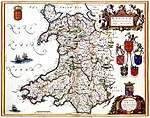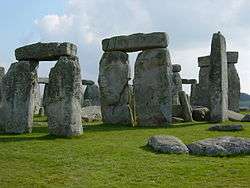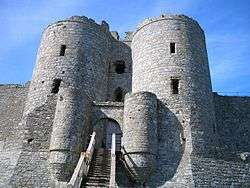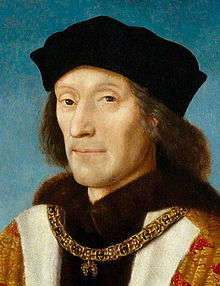Wales in the Late Middle Ages
Part of a series on the |
|---|
| History of Wales |
 |
|
Kingdoms |
|
|
Part of a series on the |
|---|
| History of the British Isles |
 |
Wales in the Late Middle Ages covers the period from the death of Llywelyn ap Gruffudd in late 1282 to the incorporation of Wales into the Kingdom of England by the Laws in Wales Acts 1535-1542.
Death of Llywelyn
After the death of Llywelyn ap Gruffudd, his brother Dafydd ap Gruffydd carried on resistance for a few months, but was never able to control any large area. He was captured and executed by hanging, drawing and quartering at Shrewsbury in 1283. King Edward I of England now had complete control of Wales. The Statute of Rhuddlan was issued from Rhuddlan Castle in north Wales in 1284. The Statute divided parts of Wales into the counties of Anglesey, Merioneth and Caernarvon, created out of the remnants of Llewelyn's Gwynedd. It introduced the English common law system, and abolished Welsh law for criminal cases, though it remained in use for civil cases. It allowed the King to appoint royal officials such as sheriffs, coroners, and bailiffs to collect taxes and administer justice. In addition, the offices of justice and chamberlain were created to assist the sheriff. The Marcher Lords retained most of their independence, as they had prior to the conquest.Most of the Marcher Lords were by now Cambro Norman i.e. Norman Welsh through intermarriage.
King Edward I and rebellions

King Edward I built a ring of impressive stone castles to consolidate his domination of Wales, and crowned his conquest by giving the title Prince of Wales to his son and heir in 1301.[1] Wales became, effectively, part of England, even though its people spoke a different language and had a different culture. English kings paid lip service to their responsibilities by appointing a Council of Wales, sometimes presided over by the heir to the throne. This Council normally sat in Ludlow, now in England but at that time still part of the disputed border area of the Welsh Marches. Welsh literature, particularly poetry, continued to flourish however, with the lesser nobility now taking over from the princes as the patrons of the poets and bards. Dafydd ap Gwilym who flourished in the middle of the fourteenth century is considered by many to be the greatest of the Welsh poets.
There were a number of rebellions including ones led by Madog ap Llywelyn in 1294-5 [2] and by Llywelyn Bren, Lord of Senghenydd, in 1316-18. In the 1370s the last representative in the male line of the ruling house of Gwynedd, Owain Lawgoch, twice planned an invasion of Wales with French support. The English government responded to the threat by sending an agent to assassinate Owain in Poitou in 1378.[3]
The Black Death
The Black Death arrived in Wales in late 1348. What records survive indicate that about 30% of the population died, in line with the average mortality through most of Europe.
Glyndŵr's rebellion
In 1400, a Welsh nobleman, Owain Glyndŵr, revolted against King Henry IV of England. Owain inflicted a number of defeats on the English forces and for a few years controlled most of Wales. Some of his achievements included holding the first Welsh Parliament at Machynlleth and plans for two universities. Eventually the king's forces were able to regain control of Wales and the rebellion died out, but Owain himself was never captured, betrayed nor tempted by Royal pardons. His rebellion caused a great upsurge in Welsh identity and he was widely supported by Welsh people throughout the country.[4]
As a response to Glyndŵr's rebellion, the English parliament passed the Penal Laws in 1402. These prohibited the Welsh from carrying arms, from holding office and from dwelling in fortified towns. These prohibitions also applied to Englishmen who married Welsh women. These laws remained in force after the rebellion, although in practice they were gradually relaxed.[5]
Wars of the Roses

In the Wars of the Roses over the English throne, which began in 1455, both sides made considerable use of Welsh troops. The main figures in Wales were the two Earls of Pembroke, the Yorkist Earl William Herbert and the Lancastrian Jasper Tudor. In 1485 Jasper's nephew, Henry Tudor, landed in Wales with a small force to launch his bid for the throne of England. Henry was of Welsh descent, counting princes such as Rhys ap Gruffydd (The Lord Rhys) among his ancestors, and his cause gained much support in Wales. Henry defeated King Richard III of England at the Battle of Bosworth with an army containing many Welsh soldiers and gained the throne as King Henry VII of England.[6]
Annexation to England
Under Henry VII's son, Henry VIII of England, the Laws in Wales Acts 1535-1542 were passed, annexing Wales to England in legal terms, abolishing the Welsh legal system, and banning the Welsh language from any official role or status, but it did for the first time define the Wales-England border and allowed members representing constituencies in Wales to be elected to the English Parliament.[7] They also abolished any legal distinction between the Welsh and the English, thereby effectively ending the Penal Code although this was not formally repealed.[8]
Notes
- ↑ Davies, R.R. Conquest, coexistence and change p. 386
- ↑ Moore, D. The Welsh wars of independence p.159
- ↑ Moore, D. The Welsh wars of independence p.164-6
- ↑ Moore, D. The Welsh wars of independence p.169-85
- ↑ Davies, J. A History of Wales p.199
- ↑ Williams, G. Recovery, reorientation and reformation pp. 217-26
- ↑ Williams, G. Recovery, reorientation and reformation pp. 268-73
- ↑ Davies, J. A History of Wales p.233
References
- John Davies, (1994) A History of Wales (Penguin Books) ISBN 0-14-014581-8
- R. R. Davies (1987) Conquest, coexistemce and change: Wales 1063-1415 (Clarendon Press, University of Wales Press) ISBN 0-19-821732-3
- John Edward Lloyd (1911) A history of Wales: from the earliest times to the Edwardian conquest (Longmans, Green & Co.)
- Kari Maund (2006) The Welsh kings: warriors, warlords and princes (Tempus) ISBN 0-7524-2973-6
- David Moore (2005) The Welsh wars of independence: c.410-c.1415 (Tempus) ISBN 0-7524-3321-0
- David Stephenson (1984) The governance of Gwynedd (University of Wales Press) ISBN 0-7083-0850-3
- Glanmor Williams (1987) Recovery, reorientation and reformation: Wales c.1415-1642 (Clarendon Press, University of Wales Press) ISBN 0-19-821733-1
- Gwyn A. Williams (1985) When was Wales?: a history of the Welsh (Black Raven Press) ISBN 0-85159-003-9
- Royal Commission on the Ancient and Historical Monuments of Wales*